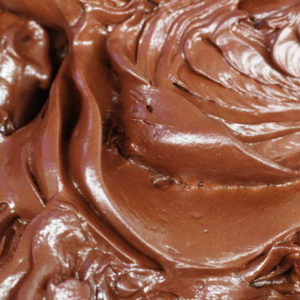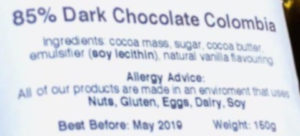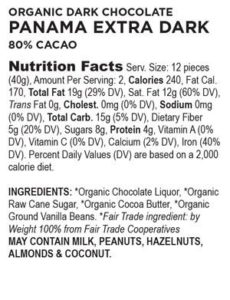The Gelato Village team pride ourselves on sourcing the very best ingredients. This includes using fantastic local milk for our gelato, and sourcing the best available seasonal fruit. Some flavours that we love are not dependent on the seasons, but we still have to be extremely careful about what we use – to make sure you always get the best possible quality gelato.
Chocolate
The chocolate we use is one of these vital ingredients. Chocolate is so common in our lives, that sometimes we can take it for granted. However the very best chocolate is a story of many parts – with sustainable farming and ethical production being fundamental parts of the process, right down to how we choose between the varieties we use for different recipes at our in-store Gelato Laboratory.
Domori chocolate
We have chosen to work with Domori Chocolate. Their founder is Gianluca Franzoni, who has dedicated his life to exploring and understanding cacao, the foundation of chocolate. Cacao is cocoa before it has been roasted. Franzoni’s company were the first in the world to use only fine cacao for their chocolate. They have helped to restore the biodiversity of Criollo cacao and were the first to produce a chocolate that was made 100% from this extremely fine quality cacao, which was previously becoming extremely endangered. This single origin bean is very aromatic and lacks bitterness. It is highly sought after around the world.
Most people who work with chocolate use ‘forastero’ beans – it is unremarkable in flavour but produces high yields so it is cheaper to use as an ingredient, or to melt down and make into new shapes like truffle shells or Easter eggs. With the help of Domori, we are able to use lower-yielding Trinitario (8% of the global cocoa harvest), Nacional (2%) and Criollo (0.001%) chocolates which have much more complexity and depth of flavour.
No added flavourings
Domori have learned from the ancient methods of chocolate production in places like South America. They make chocolate using only cocoa paste and sugar. They never use additives like butter or vanilla. A high quality chocolate has everything needed in terms of flavour, so should not need anything added! Always check the label when buying high quality chocolate to make sure you are buying the pure product. We provide the ingredients of our gelato recipes in a folder which is available to the public in Gelato Village at all times.
Pictured here is the ingredient label from our 2018 Easter eggs, which we made in store using Domori chocolate. For comparison there is a label from a local chocolate shop’s 85% Columbian chocolate and a national brand’s 80% Panamanian chocolate. Notice that both these competitors’ products have a higher proportion of cocoa solids to sugar (you can buy chocolate that is right up to 100% cocoa solids). The reason to have a higher percentage of cocoa solids is to increase the concentration of flavour in the finished chocolate. A high quality chocolate has complex and often delicate layers of aroma and flavour – so why spoil it by adding the powerful (and expensive) flavouring that vanilla brings? However, if the chocolate isn’t of a particular high quality in the first place then you need to add flavour.
Misconceptions about dark chocolate
Sometimes, there is a misconception that dark chocolate is always bitter. Again, this is not necessarily true, but is a question of quality. A forastero chocolate (the bulk produced, lowest quality chocolate) will taste more bitter. This means that more sugar is needed to make it nice to eat, and more other flavourings to mask the bitter taste.
A high quality chocolate like a Trinitario is full of complex aromas, so the higher the percentage of cocoa solids, the more intense and flavoursome it tastes. But it is not more bitter! This is why we use these chocolates for the various things we make ourselves at Gelato Village. Our chocolate gelato and sorbetto recipes benefit from the different chocolate flavour profiles. Through the year we make a range of cakes and confections that use chocolate too – like pralines, ganache and chocolate dipped candied peel. The higher the quality, the better the final flavour!
How is chocolate made?
Cocoa is difficult to grow, and much of the process is done by hand – whatever the quality of chocolate. This makes it important for big business to produce the small families who are the world’s cocoa farmers. These farmers harvest the ripe cocoa pods and the insides, which contains the cocoa beans, are scooped out. This is all fermented for up to a week then the beans are dried, usually in a single layer in the sun. Beans grown in wetter climates may be dried next to wood fires.
At this point, the chocolate producer usually takes over to roast the beans. The temperature and length of time the beans are roasted for has an impact on the final flavour. The beans are cracked and the thin shells are removed in a process called winnowing. What is left behind is pure pieces of cocoa beans – known as nibs.
The nibs are ground to make a paste called cocoa mass or cocoa liquor. The cocoa butter can be extracted at this point if needed. Cheaper chocolate manufacturers will add cheaper vegetable fats to make the chocolate smoother and glossier – watch the ingredient list to make sure this hasn’t happened to your chocolate! This is when the sugar is also added to the chocolate.
The melted chocolate will be tempered so that it has a good texture, then can be shaped using whatever mould the producer prefers. This could be bars or buttons for a large producer, or straight into the final shape for the customer if a smaller producer also shapes their own chocolate. We buy buttons, called callets, which are easy to re-melt and use in all of the delicious chocolate products we make at Gelato Village. Chocolate makers can use moulds or shape the re-melted chocolate by hand to make the final product. We use moulds to make our Easter eggs and shape our pralines by hand, for example.








